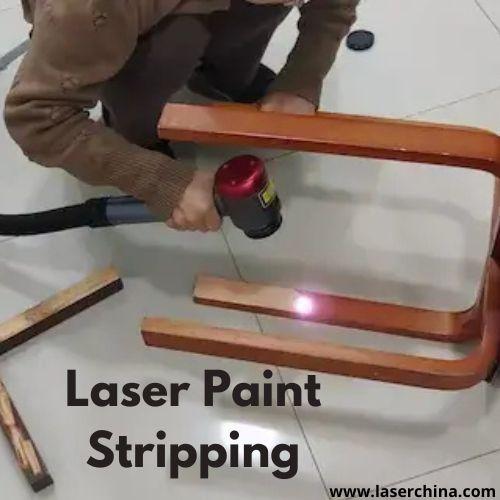Laser Paint Stripping: Revolutionizing Surface Preparation with Precision and Efficiency

Laser paint stripping has emerged as a game-changing technology in the field of surface preparation and finishing. Traditional methods of paint removal, such as chemical strippers, sandblasting, and mechanical abrasion, often involve hazardous substances, generate significant waste, and risk damaging the underlying material. Laser paint stripping, however, provides a modern, efficient, and environmentally conscious alternative that is transforming industries ranging from aerospace to automotive, maritime, and industrial maintenance.
At its core, laser paint stripping uses highly concentrated light beams to remove paint, coatings, and surface contaminants from various substrates. The laser energy interacts with the coating material, causing it to break down, vaporize, or detach from the surface without affecting the base material. This process is precise, controllable, and highly adaptable, allowing operators to target even complex shapes, delicate surfaces, and hard-to-reach areas with consistent results.
One of the most notable aspects of laser paint stripping is its ability to handle diverse materials. From metals such as steel, aluminum, and titanium to composites, plastics, and even ceramics, laser technology can be tailored to the specific properties of the substrate. This adaptability makes it an invaluable tool for industries where maintaining material integrity is critical. For instance, in aerospace, components often feature intricate geometries and lightweight alloys that are easily damaged by conventional stripping methods. Laser paint stripping addresses these challenges without compromising the part’s structural properties.
Environmental considerations play a significant role in the growing adoption of laser paint stripping. Traditional paint removal techniques often involve harsh chemicals or abrasive media that produce hazardous waste, require extensive disposal measures, and pose health risks to workers. In contrast, laser systems operate without chemicals, reduce waste, and minimize environmental impact. The process generates only minute amounts of particulate matter, which can be safely collected through filtration systems. This cleaner approach aligns with modern regulatory standards and sustainability initiatives, making it a preferred choice for companies looking to reduce their ecological footprint.
Another factor driving the popularity of laser paint stripping is its efficiency. Laser systems can be configured to operate at high speeds while maintaining precision, enabling large-scale operations to maintain productivity without compromising quality. The process is highly repeatable, ensuring consistent results across multiple components or production batches. For manufacturers and service providers, this translates into reduced downtime, lower labor requirements, and faster turnaround times compared to traditional methods.
Safety is also a key consideration. Workers involved in chemical stripping or abrasive blasting are exposed to toxic fumes, dust, and high levels of noise. Laser paint stripping, when operated under proper safety protocols, minimizes direct human contact with harmful substances and reduces occupational hazards. Enclosures, ventilation systems, and automated handling further enhance safety while allowing operators to focus on process control and precision.
The versatility of laser paint stripping extends beyond industrial applications. In heritage conservation and restoration, laser technology has proven invaluable for removing paint, varnish, and coatings from historical artifacts, sculptures, and architectural surfaces. Its precision allows conservators to remove unwanted layers without harming delicate original materials, preserving the authenticity and integrity of valuable cultural assets. Similarly, in the automotive restoration industry, laser paint stripping offers a way to remove old or deteriorated coatings from classic vehicles while maintaining the underlying bodywork.
Integration with modern automation technologies further enhances the capabilities of laser paint stripping. Robotic arms, CNC-controlled systems, and computer-guided platforms allow for precise movement, consistent treatment, and minimal human intervention. This integration is especially beneficial in high-volume production environments, where repeatability and uniformity are critical. Operators can program specific parameters for different parts, materials, and coatings, ensuring optimal results without constant manual adjustments.
Maintenance and operational efficiency are also important considerations. Laser systems are designed for long-term performance with minimal downtime. They require routine calibration and cleaning, but unlike chemical baths or abrasive setups, they do not necessitate constant replacement of consumables. This reduces operational costs and contributes to the overall sustainability and efficiency of the process.
As industries increasingly prioritize sustainability, precision, and safety, laser paint stripping continues to gain traction as a reliable, high-performance solution. Its combination of adaptability, efficiency, and minimal environmental impact makes it suitable for a wide range of sectors, including aerospace, automotive, industrial maintenance, heritage restoration, and beyond. Companies investing in this technology are positioning themselves at the forefront of modern surface treatment methods, enhancing productivity, protecting materials, and reducing ecological impact.
Laser paint stripping is more than just a technological advancement—it represents a shift in how industries approach surface preparation. By replacing traditional, resource-intensive methods with precise, controlled, and environmentally conscious processes, it offers a forward-looking solution for the challenges of modern manufacturing, restoration, and maintenance.
Final Thoughts
Laser paint stripping exemplifies the convergence of precision engineering, environmental responsibility, and operational efficiency. As industries continue to evolve, its role in surface preparation and coating removal is set to expand, offering a reliable, versatile, and future-ready alternative to traditional methods. The adoption of laser technology in paint stripping marks a significant step toward safer, cleaner, and more precise industrial processes.
- Art
- Causes
- Crafts
- Dance
- Drinks
- Film
- Fitness
- Food
- Giochi
- Gardening
- Health
- Home
- Literature
- Music
- Networking
- Altre informazioni
- Party
- Religion
- Shopping
- Sports
- Theater
- Wellness


